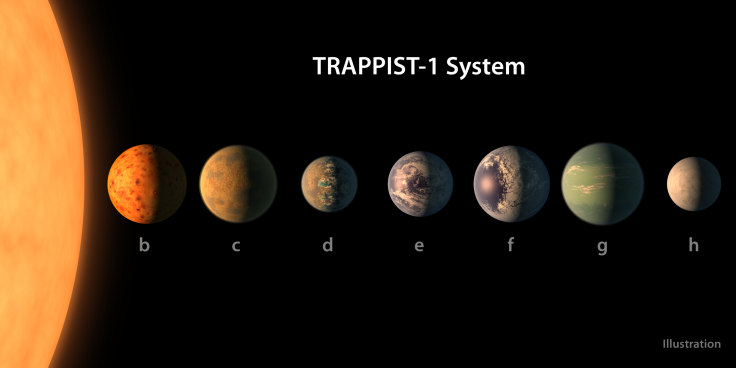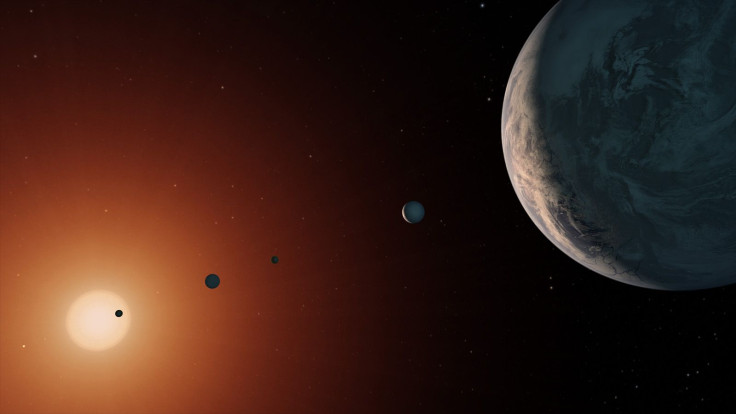NASA Says Trappist-1 Planetary System Is Older Than Our Own Solar System

Earlier this year, both the scientific community and “alien enthusiasts” were excited when NASA announced in February it had found a star system 40 light-years away with seven Earth-size rocky planets. Called Trappist-1, the system is thought to have at least three of those planets in a potentially habitable zone with the possibility of liquid surface water.
But being located at the right distance from the parent star is not nearly enough for a planet to be actually habitable because life as we know it doesn’t seem to spring up so easily. Among the many and varied factors, take, for example, the matter of the star’s age. Trappist-1 is thought to be anywhere between 5.4 billion years and 9.8 billion years old, which is at least 20 percent (and up to over 100 percent) older than our own solar system that formed about 4.5 billion years ago.
In a statement Friday, NASA explained: “If we want to know more about whether life could survive on a planet outside our solar system, it’s important to know the age of its star. Young stars have frequent releases of high-energy radiation called flares that can zap their planets’ surfaces. If the planets are newly formed, their orbits may also be unstable. On the other hand, planets orbiting older stars have survived the spate of youthful flares, but have also been exposed to the ravages of stellar radiation for a longer period of time.”

To estimate the age of Trappist-1, Adam Burgasser, an astronomer at the University of California, San Diego, and Eric Mamajek, deputy program scientist for NASA’s Exoplanet Exploration Program based at NASA’s Jet Propulsion Laboratory, Pasadena, California, used a number of indirect clues. These included the speed of the star as it moves in its orbit within the Milky Way (older is usually faster), the chemical composition of its atmosphere and the number of flares seen during observation periods.
The old age estimation they arrived at is not very unusual for the kind of star Trappist-1 is — an ultra-cool dwarf. It has a mass of less than a tenth of the sun, and its planets are all very close orbits to it. Despite the relatively cool temperature, radiation from the star cloud has, over billions of years, evaporated any atmosphere and water that may have existed on any of the three planets in the habitable zone — much the same way as Mars.
All the planets of Trappist-1 are thought to be rocky but with densities lower than Earth, it is also possible that volatile molecules (like water and carbon dioxide) create a thick atmosphere, thereby shielding the planets from most of the harmful radiation. The planets are also thought to be tidally locked to the star (the same side always faces the star, like the moon and Earth), so an atmosphere would also mean that some of the incoming heat would be distributed to the planets’ night side too. But a very thick atmosphere also creates the possibility of an excessive greenhouse effect, which would overheat the planet, like on Venus.
“If there is life on these planets, I would speculate that it has to be hardy life because it has to be able to survive some potentially dire scenarios for billions of years,” Burgasser, first author of a new research paper on the topic, said in the statement. “Our results really help constrain the evolution of the TRAPPIST-1 system, because the system has to have persisted for billions of years. This means the planets had to evolve together, otherwise the system would have fallen apart long ago,” he added.
This provides more evidence of the system’s stability, which was first initially thought to be very unstable and the planets doomed to crash into each other in less than one million years. Previously, a study published in May by scientists and musicians from the University of Toronto said the planets had very stable orbits that formed ratios of whole numbers.

The temperature and brightness of stars the mass of Trappist-1 tend to remain more or less constant over very long periods of time, even in terms of cosmic time-scales. With the exception of occasional magnetic flaring events, the lifetime of Trappist-1 is estimated to be over 10 trillion years (the universe is only 13.7 billion years, by comparison.
“Stars much more massive than the sun consume their fuel quickly, brightening over millions of years and exploding as supernovae. But Trappist-1 is like a slow-burning candle that will shine for about 900 times longer than the current age of the universe,” Mamajek said in the statement.
Trappist-1 is so-named because the main instrument that led to its discovery is Transiting Planets and Planetesimals Small Telescope (TRAPPIST) in Chile. NASA’s Spitzer Space Telescope and other ground-based telescopes were also used in the discovery of the star system.
The paper by Burgasser and Mamajek, titled “On the Age of the Trappist-1 System,” has been accepted for publication in the Astrophysical Journal and is available online on the preprint server arXiv.
© Copyright IBTimes 2024. All rights reserved.





















